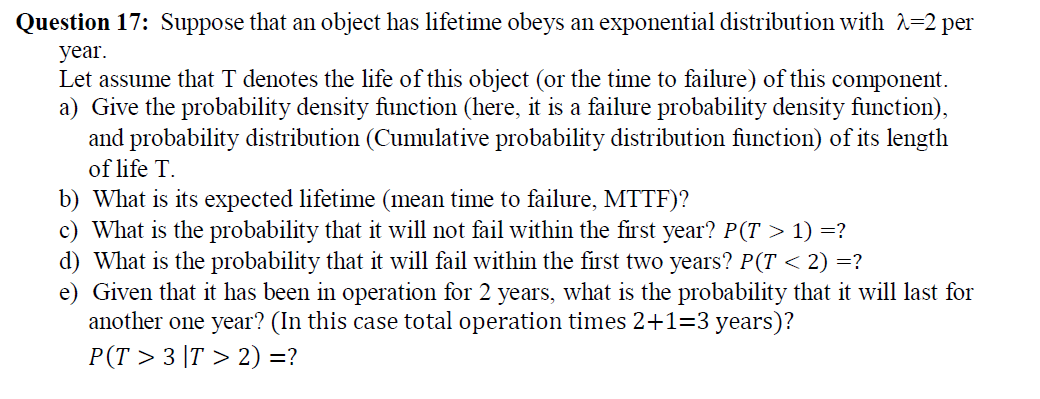Question 17: Suppose that an object has lifetime obeys an exponential distribution with 2=2 per year. Let assume that T denotes the life of this object (or the time to failure) of this component. a) Give the probability density function (here, it is a failure probability density function), and probability distribution (Cumulative probability distribution function) of its length of life T. b) What is its expected lifetime (mean time to failure, MTTF)? c) What is the probability that it will not fail within the first year? P(T > 1) =? d) What is the probability that it will fail within the first two years? P(T < 2) =? e) Given that it has been in operation for 2 years, what is the probability that it will last for another one year? (In this case total operation times 2+1=3 years)? Р(T > 3 1T > 2) 3?
Addition Rule of Probability
It simply refers to the likelihood of an event taking place whenever the occurrence of an event is uncertain. The probability of a single event can be calculated by dividing the number of successful trials of that event by the total number of trials.
Expected Value
When a large number of trials are performed for any random variable ‘X’, the predicted result is most likely the mean of all the outcomes for the random variable and it is known as expected value also known as expectation. The expected value, also known as the expectation, is denoted by: E(X).
Probability Distributions
Understanding probability is necessary to know the probability distributions. In statistics, probability is how the uncertainty of an event is measured. This event can be anything. The most common examples include tossing a coin, rolling a die, or choosing a card. Each of these events has multiple possibilities. Every such possibility is measured with the help of probability. To be more precise, the probability is used for calculating the occurrence of events that may or may not happen. Probability does not give sure results. Unless the probability of any event is 1, the different outcomes may or may not happen in real life, regardless of how less or how more their probability is.
Basic Probability
The simple definition of probability it is a chance of the occurrence of an event. It is defined in numerical form and the probability value is between 0 to 1. The probability value 0 indicates that there is no chance of that event occurring and the probability value 1 indicates that the event will occur. Sum of the probability value must be 1. The probability value is never a negative number. If it happens, then recheck the calculation.
Question d and e for the first probem.
Question b, c and d for the second problem.

![Question 7: A diagnostic test is administered to a random person to determine if they have a
certain disease. Consider the events: T = "the test is positive,", T = "the test is negative,"
D = "the person has the disease," and D = "the person has not the disease,"
Suppose that the test has the following "false positive" and "false negative" probabilities:
P(T|D) = 0.02 (i.e., 2%) and P(T|D) = 0.04 (i.e., 4%).
a) For any events A, B the Law of Total Probability says P(A) = P(AN B) + P(A O B).
Use this to prove that
b) Compute the probability P(T|D) of a “true positive" and the probability P(T|D) of “true
negative".
c) Assume that 10% of the population has this disease, i.e., P(D) = 0.1. What is the probability that
a random person will test positive?
d) Suppose that a random person is tested and the test returns positive. What is the probability that
this person actually has the disease? Is this a good test? [Hint: We are looking for the probability
P(D|T)].
%3D
1 = P(B|A) + P(B|A)](/v2/_next/image?url=https%3A%2F%2Fcontent.bartleby.com%2Fqna-images%2Fquestion%2F8399ad39-cc70-47e3-b6d3-f118d9d6052b%2Fef7326c6-ad77-4041-bfad-14f91903f8c7%2Fiw3943p_processed.png&w=3840&q=75)
Step by step
Solved in 2 steps with 2 images




